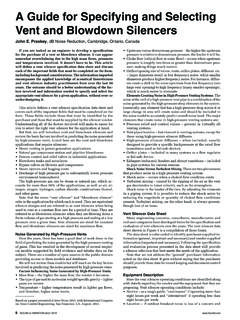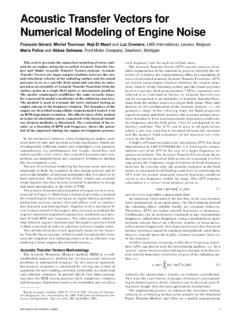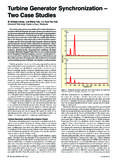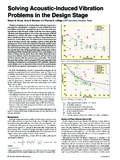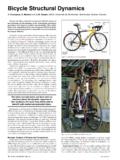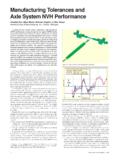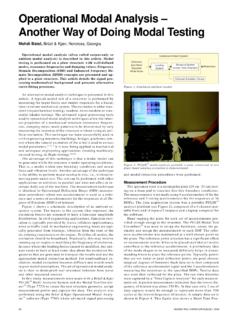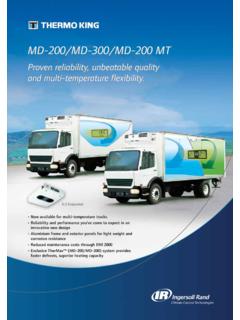Transcription of International Standards for Specifying Noise …
1 SOUND & VIBRATION/DECEMBER 2013 13 The basic elements of a buy-quiet program are well known. One or more databases of Noise emission data are helpful in preparing Noise requirements, and a Noise specification sheet is an essential element of a program. The Noise limit must be speci-fied, and both the Noise metric and the standard used to make the measurement must be included in the specification. The machine operating conditions during measurement must be agreed upon. A method for the verification that a specification has been met is also important. The emphasis in this article is on International Standards related to the specification of Noise emissions. There are Standards that can be used for determining both sound power and sound pressure, some applicable to any equipment and some applicable to specific types of machines.
2 In addition to an American national standard on Noise specifications, there are also many country-specific Standards and numerous European norms. This article mentions the American situation briefly, but a listing of other country-specific documents and European norms is not included in this the United States, the Technology for a Quieter America (TQA) report1 published in October 2010 contains information on buy-quiet programs, especially in connection with occupational Noise issues. The National Aeronautics and Space Administration (NASA) developed a roadmap for implementing buy-quiet pro-grams aimed at preventing hearing loss,2 and the National Institute for Occupational Safety and Health (NIOSH) is in the process of developing a similar Internationally, the Buy-Quiet 2011 Symposium in Paris was an International INCE Symposium that brought together individuals from many countries with experience in developing and implementing such programs.
3 The keynote address and the abstracts (with links to the presentation slides) were published in the September 2011 issue of Noise /News As these programs evolve, it will be necessary to specify the Standards used to determine the Noise emissions of products as well as the Noise metric (sound power or pressure) to be the INTER- Noise 2011 Congress in Osaka, Japan, establishing a new technical study group on buy-quiet programs was approved by the International Institute of Noise Control Engineering (I-INCE). In support of the work, the author submitted a short draft report5 titled Guidelines for the Development of Buy-Quiet Programs. One of the missing elements in the draft was a description of the International Standards available for the specification of Noise emissions.
4 The intent of this article is to provide such a descrip-tion that would be useful for the I-INCE project as well as other buy-quiet programs in National Standard (R2012), Guidelines for the Specification of Noise of New Machinery, contains information on Noise emission Standards published by organizations in the Although the standard was reaffirmed in 2012, it was originally published in 1992 and needs to be the new technical study group mentioned above, the pri-mary emphasis will be on the Noise emissions of stationary sound sources. For that reason, the compilations below do not include emission Standards for moving Emission StandardsIn the TQA report, Chapter 6 on Standards and Regulations for Product Noise Emissions is an overview of the subject in the and particularly in Europe.
5 The chapter can be read online1 and will not be summarized here. The Noise emission Standards published by the International Organization for Standardization (ISO) and the International Electrotechnical Commission (IEC) are of particular importance. These Standards were not listed in the TQA report but will be listed here. ISO Noise emission Standards can broadly be divided into two categories generic Standards that can be used for determining the Noise emissions of any piece of equipment and Standards that are applicable to a specific type of former are the work of ISO Technical Committee 43/Sub-committee 1, Noise . Except for Standards published for use by the information technology industry, these Standards generally do not contain information on the operating conditions of the equipment to be used during measurement.
6 There are a large number of ISO technical committees, and many of these have published Noise emission Standards applicable to a specific type of equipment. Appendix C of the TQA report4 contains additional information on Standards development with emphasis on activities in the and on ISO/IEC activities. The list below is reproduced from the TQA Committees with an Interest in NoiseThe following technical committees of the International Orga-nization for Standardization ( ) have an interest in Noise or sound: TC 4 Roller bearings TC 21/SC 3 Equipment for fire protection and fire fighting/fire detection and alarm systems TC 22/SC 22 Motorcycles TC 23/SC 2 Tractors and machinery for agricultural forestry/common tests TC 23/SC 3 Tractors and machinery for agricultural forestry/safety and comfort TC 23/SC 17 Tractors and machinery for agricultural forestry/manually portable forest machinery TC 36 Cinematography TC 39/SC 6 Machine tools/ Noise of machine tools TC 43/SC 1 Acoustics/ Noise TC 43/SC 2 Acoustics/building acoustics TC 60 Gears TC 70 Internal combustion engines TC 72/SC 8 Textile machinery and accessories/safety require-ments for textile
7 Machinery TC 86 Refrigeration and air conditioning TC 86/SC 3 Testing and rating of factory-made refrigeration sys-tems (excluding systems covered by Subcommittees 5, 6, and 7) TC 86/SC 5 Refrigeration and air conditioning/testing and rating of household refrigeration appliances TC 86/SC 6 Factory-made air-cooled, air-conditioning and air-to-air heat pump units TC 108/SC 2 Measurement and evaluation of mechanical vibra-tion and shock as applied to machines, vehicles, and structures TC 115 Pumps TC 117 Industrial fans TC 118/SC 3 Compressors and pneumatic tools, machines, and equipment/pneumatic tools and machines TC 118/SC 6 Compressors and pneumatic tools, machines, and equipment/air compressors and compressed air systems TC 127/SC 2 Earth-moving machinery/safety, ergonomics.
8 And general requirements TC 131/SC 8 Fluid power systems/product testing TC 160/SC 2 Glass in buildings/use considerations TC 188 Small craftInternational Standards for Specifying Noise EmissionsGeorge C. Maling, Jr., Harpswell, MaineThis article is a revised version of a paper presented at Inter- Noise 2012, the 2012 International Congress and Exposition on Noise Control Engineering held in New York City, USA on August 19-22, SOUND & VIBRATION/DECEMBER 2013 IEC ( ) Noise emission Standards are mainly applied to household appliances and rotating next two sections of this paper are listings of ISO and IEC Standards related to Noise emissions. Noise emissions from trans-portation sources are not included in the for Noise EmissionsAs mentioned above, generic Standards for determining Noise emissions are produced by ISO TC 43/SC 1, Noise .
9 These docu-ments relate either to the determination of sound power level or emission sound pressure level; those two topics are separated in the listing below. In addition, ISO TC 43/SC 1 publishes Standards related to specific types of equipment and Standards related to declaration and verification of Noise emissions. These documents are also listed below. There are four Noise emission Standards from ISO TC 43/SC 2, Building Acoustics, and then a very large num-ber of Standards for different types of machinery. These are listed below. A number of technical committees produce IEC Standards related to Noise (also listed below).ISO Standards from ISO TC 43/SC 1, Measurement Methods Sound Power ISO 3740:2000 Acoustics: Determination of sound power levels of Noise sources; guidelines for the use of basic Standards .
10 ISO 3741:2010 Acoustics: Determination of sound power levels and sound energy levels of Noise sources using sound pressure; precision methods for reverberation test rooms. ISO 3743-1:2010 Acoustics: Determination of sound power levels and sound energy levels of Noise sources using sound pressure; engineering methods for small movable sources in reverberant fields; Part 1: Comparison method for a hard-walled test room. ISO 3743-2:1994 Acoustics: Determination of sound power levels of Noise sources using sound pressure; engineering methods for small, movable sources in reverberant fields, Part 2: Methods for special reverberation test rooms. (ISO 3743-2:1994/NP Amendment 1.)
